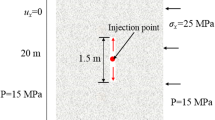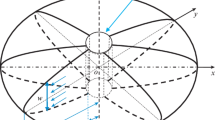Abstract
The article presents the analytical model and calculation results on fracture growth in layered rock mass during blasting and hydraulic fracturing in oil reservoirs. The stress state of fractured elastic rock mass is found using 3D boundary element method. The influence of strength characteristics of layered rock mass on the shape, size and area of radial fractures is determined. The presence of a stronger layer in rock mass restrains cross sectional growth of induced fractures as compared with the existing fractures in surrounding rock mass, i.e. nonuniform fracture of rock mass along boreholes and probable oversizes are prevented in this case. It is possible to adjust the shape of fractures by changing distribution of an explosive along the borehole. During hydraulic fracturing, fractures propagate chiefly along a softer rock layer if present.





Similar content being viewed by others
REFERENCES
Mosinets, V.N., Drobyashchee i seismicheskoe deistvie vzryva v gornykh porodakh (Crushing and Seismic Effect of Blasting in Rocks), Moscow: Nedra, 1976.
Kutuzov, B.N. and Andrievsky, A.P., Novaya teoriya i novye tekhnologii razrusheniya gornykh porod udlinennymi zaryadami vzryvchatykh veshchestv (New Theory and New Technologies for Rock Destruction by Elongated Explosive Charges), Novosibirsk: Nauka, 2002.
Aleksandrova, N.I. and Sher, E.N., Effect of Dilation on Rock Breaking by Explosion of a Cylindrical Charge, J. Min. Sci., 1999, vol. 35, no. 4, pp. 400–408.
Vokhmin, S.A., Kurchin, G.S., Kirsanov, A.K., and Gribanova, D.A., Review of Existing Procedures for Calculating the Parameters of Failure Zones in a Rock Mass. Part I, Sovr. Probl. Nauk. Obr., 2015, no. 1, p. 401.
Sher, E.N. and Chernikov, A.G., Calculation of Parameters of Radial Fractures Formed during Elongated Charge Blasting in Brittle Rocks,Fund. Prikl. Vopr. Gorn. Nauk, 2015, no. 2, pp. 299–303.
Grigoryan, S.S., Some Problems of Mathematical Theory of Solid Rock Deformation and Failure, PMM, 1967, vol. 31, no. 4, pp. 643–669.
Rodionov, V.N., Adushkin, V.V., Romashev, A.N., et al.,Mekhanicheskii effekt podzemnogo vzryva (Mechanical Effect of an Underground Explosion), Moscow: Nedra, 1971.
Chadwick, P., Cox, A.D., and Hopkins, H.G., Mechanics of Deep Underground Explosions, Philosoph. Trans. Roy. Soc., London, 1964.
Sher, E.N. and Aleksandrova, N.I., Dynamics of Development of Crushing Zone in Elastoplastic Medium in Camouflet Explosion of String Charge, J. Min. Sci., 1997, vol. 33, no. 6, pp. 529–535.
Crouch, S.L. and Starfield, A.M., Boundary Element Methods in Solid Mechanics, George Allen & Unwin, London, 1983.
Peach, M. and Koehler, J.S., The Forces Exerted on Dislocations and the Stress Fields Produced by Them, Phys. Rev., 1950, vol. 80, no. 3, pp. 436–440.
Mikhailov, A.M., Calculation of the Stresses around a Crack,J. Min. Sci., 2000, vol. 36, no. 5, pp. 445–451.
Sher, E.N. and Chernikov, A.G., Calculation of Parameters of Radial Fractures Formed during Elongated Charge Blasting in Brittle Rocks,Fund. Prikl. Vopr. Gorn. Nauk, 2015, no. 2, pp. 299–303.
Sher, E.N., Determination of Shape and Sizes of Radial Fractures in Layered Rock Mass that Formed during Borehole Charge Blasting and Hydraulic Fracturing, Fund. Prikl. Vopr. Gorn. Nauk, 2019, vol. 6, pp. 266–271
Kristianovich, S.A. and Zheltov, Yu.P., Formation of Vertical Fractures by Means of Highly Viscous Fluids, Proc. of 4th World Petroleum Congress, Rome, Italy, 1955.
Perkins, T.K. and Kern, L.R., Widths of Hydraulic Fractures,J. of Petroleum Technol., 1961, vol. 13, no. 9, pp. 937–949.
Geertsma, J., Chapter 4, Two-Dimensional Fracture Propagation Models, Resent Advances in Hydraulic Fracturing, Monograph Series, Eds. Gigley J., Holditch S., Veatch D. N. R., Richardson TX, PE, 1989.
Adachi, J.I., Detournay, E., and Peirce, A.P., An Analysis of the Classical Pseudo-3D Model for Hydraulic Fracture with Equilibrium Height Growth across Stress Barriers, J. Rock Mech. and Min. Sci., 2010, vol. 47, no. 4, pp. 625–639.
Zhang, X., Wu, B., Jeffrey, R.G., Connell, L.D., and Zhang, G., A Pseudo-3D Model for Hydraulic Fracture Growth in a Layered Rock,Int. J. of Solids and Structures, 2017, vols. 115, 116, pp. 208–223.
Xu, B., Liu, Y., Wang, Y., Yang, G., Yu, Q., and Wang, F., A New Method and Application of Full 3D Numerical Simulation for Hydraulic Fracturing Horizontal Fracture, Energies, 2019, vol. 12, no. 1 (48).
Serdyukov, S.V., Patutin, A.V., Shilova, T.V., Azarov, A.V., and Rybalkin, L.A., Technologies for Increasing Efficiency of Solid Mineral Mining with Hydraulic Fracturing, J. Min. Sci., 2019, vol. 55, no. 4, pp. 596–602
Alekseenko, O.P. and Vaisman, A.M., Nonsymmetric Growth of Hydraulic Fracture, MTT, 1996, no. 1, pp. 107–113.
Kolykhalov, I.V., Panov, A.V., and Skulkin, A.A., Influence of Working Fluid Properties on Symmetry of the Shape of Hydraulic Fracture Transverse to the Borehole, Fund. Prikl. Vopr. Gorn. Nauk, 2019, vol. 6, no. 3, pp. 77–81.
Author information
Authors and Affiliations
Corresponding author
Additional information
Translated from Fiziko-Tekhnicheskie Problemy Razrabotki Poleznykh Iskopaemykh, 2020, No. 6, pp. 42–53. https://doi.org/10.15372/FTPRPI20200604.
Rights and permissions
About this article
Cite this article
Sher, E.N. MODELING PROPAGATION OF FRACTURES IN LAYERED ROCK MASS DURING BLASTING AND HYDRAULIC FRACTURING. J Min Sci 56, 914–924 (2020). https://doi.org/10.1134/S1062739120060046
Received:
Published:
Issue Date:
DOI: https://doi.org/10.1134/S1062739120060046




